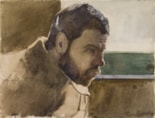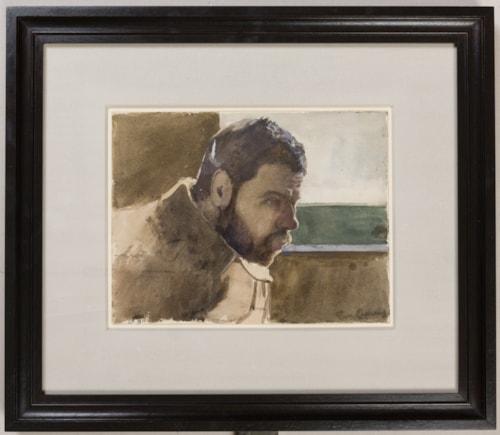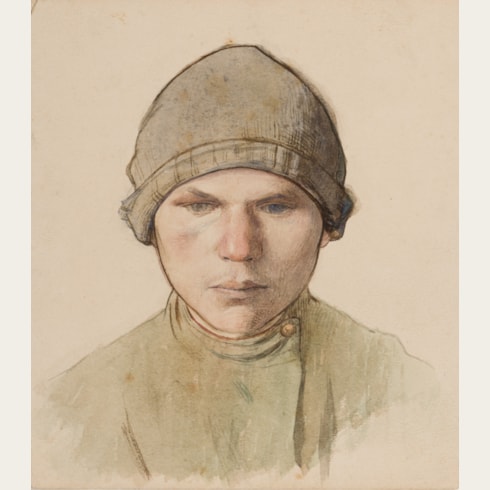Jean-Pierre LAURENS
(Paris 1875 - Fontenay-aux-Roses 1932)
Portrait of a Prisoner, Looking Down to the Right
Pen and brown ink and brown wash, and watercolour.
Signed Pierre Laurens at the lower right.
Numbered and dated III 1915 at the lower left.
Numbered 16 and III on the verso.
198 x 260 mm. (7 3/4 x 10 1/4 in.)
Signed Pierre Laurens at the lower right.
Numbered and dated III 1915 at the lower left.
Numbered 16 and III on the verso.
198 x 260 mm. (7 3/4 x 10 1/4 in.)
On 25 September 1914 Laurens was wounded by a bullet in his right leg and taken prisoner by the Germans. He was transferred to the prisoner of war camp at Wittenberg, on the Elbe river in Saxony-Anhalt, which became notorious for its appalling conditions, with 15,000 French, Belgian, British and Russian prisoners of war confined in overcrowded and unsanitary conditions. During his three years as a captive at Wittenberg, Laurens produced a number of drawings and watercolours of everyday life in the camp and of his fellow prisoners. These drawings recorded the harsh conditions of captivity and, in particular, the ravages caused by the typhus epidemic in the camp in 1915.
The present sheet is likely to depict a Russian prisoner of war in the camp at Wittenberg. Laurens made several drawings and watercolours of his fellow prisoners. As the artist recalled of his time in the camp, in a letter written after the war, ‘As soon as it was possible, I started to draw my comrades on a piece of paper, and then I was able to obtain a small album. A great day was the arrival of a block [of paper], paintbrushes and colours. This coincided with the arrival of the Russians in our hut. They had been in the camp for a month, but we had not been able to see them up close. I was in awe of the grandeur of their appearance and had a burning desire to work on drawings of them. Events made it easier for me. When I received the paper, the barracks offered a sight that you cannot imagine. We had the Russians and the colonial riflemen. They were beautiful too. An unusual mix.’
It may have been the arrival of Russian prisoners at Wittenberg that led to the typhus epidemic and the subsequent quarantine, which lasted for about six months, until the summer of 1915. During this time of isolation, with the prisoners having little or no direct contact with the Germans outside the barbed wire, Laurens was able to work relatively freely. As he wrote in a letter of July 1915, ‘I have adopted a Russian barracks in which I draw very often…I put all my effort into keeping it together. It’s difficult. It always comes between you and nature. To give chase is hard work. To look at a human face with an absolutely pure heart is an arduous test for one who has dedicated his life to the expression of visible forms. I have convinced myself of this here.’
The present sheet may depict the same Russian prisoner who appears in several other 1915 watercolours by Laurens. In one of these the sitter is identified as ‘Yosef’, who is mentioned by the artist in a letter: ‘If you only knew what kind of people I have lived among! In the misery of the beginning, when I painted the head with half-closed-eyes and purple lips of poor Yosef, the Muslim from Siberia...’
The present sheet is likely to depict a Russian prisoner of war in the camp at Wittenberg. Laurens made several drawings and watercolours of his fellow prisoners. As the artist recalled of his time in the camp, in a letter written after the war, ‘As soon as it was possible, I started to draw my comrades on a piece of paper, and then I was able to obtain a small album. A great day was the arrival of a block [of paper], paintbrushes and colours. This coincided with the arrival of the Russians in our hut. They had been in the camp for a month, but we had not been able to see them up close. I was in awe of the grandeur of their appearance and had a burning desire to work on drawings of them. Events made it easier for me. When I received the paper, the barracks offered a sight that you cannot imagine. We had the Russians and the colonial riflemen. They were beautiful too. An unusual mix.’
It may have been the arrival of Russian prisoners at Wittenberg that led to the typhus epidemic and the subsequent quarantine, which lasted for about six months, until the summer of 1915. During this time of isolation, with the prisoners having little or no direct contact with the Germans outside the barbed wire, Laurens was able to work relatively freely. As he wrote in a letter of July 1915, ‘I have adopted a Russian barracks in which I draw very often…I put all my effort into keeping it together. It’s difficult. It always comes between you and nature. To give chase is hard work. To look at a human face with an absolutely pure heart is an arduous test for one who has dedicated his life to the expression of visible forms. I have convinced myself of this here.’
The present sheet may depict the same Russian prisoner who appears in several other 1915 watercolours by Laurens. In one of these the sitter is identified as ‘Yosef’, who is mentioned by the artist in a letter: ‘If you only knew what kind of people I have lived among! In the misery of the beginning, when I painted the head with half-closed-eyes and purple lips of poor Yosef, the Muslim from Siberia...’
The son of the history painter and sculptor Jean-Paul Laurens, Jean-Pierre (known as Pierre) Laurens entered the Ecole des Beaux-Arts in Paris in 1895, studying with Léon Bonnat. He made his debut at the Salon des Artistes Français in 1898, winning a third-class medal, while the following year he won a silver medal and a travel grant, which he used to visit North Africa and Italy. His earliest exhibited works were mainly genre subjects and portraits. He also won a medal at the Salon of 1906, and in later years was a member of the Salon jury. Shortly after the outbreak of the First World War, Laurens served in the French 25th Territorial infantry regiment. Captured by the Germans in 1914, he spent much of the next four years at a prisoner of war camp in Wittenberg in Germany before being repatriated to France in 1918. After the war, Laurens continued his artistic career with renewed success, and was appointed a professor at the Ecole des Beaux-Arts in Paris in 1924, a post he retained until 1931, when he retired for reasons of ill health. He also taught at the Académie Julian, and in 1930 was elected to the Académie des Beaux-Arts. Apart from elegant portraiture, Laurens became known for his religious pictures, executed in a simple and direct manner somewhat akin to that of the painter Maurice Denis, who was a few years older. His most significant public commission was for the decoration of the newly-built church of Notre-Dame-du-Calvaire in Chatillon, a suburb southwest of Paris, constructed between 1932 and 1934. Laurens had received the commission from Cardinal Jean Verdier, archbishop of Paris, in 1928, but was only able to produce sketches for the project before his death in 1932. The extensive fresco decoration of the church - supervised by the artist’s wife, the painter and sculptor Yvonne Diéterle Laurens – was undertaken by several of his students, and was only completed in 1962. Paintings by Laurens are today in the collections of the museums of Beauvais, Bordeaux, Fécamp and Rouen, as well as in the Musée national d’Art moderne and the Musée de l’Armée in Paris.
Provenance
By descent in the family of the artist.







